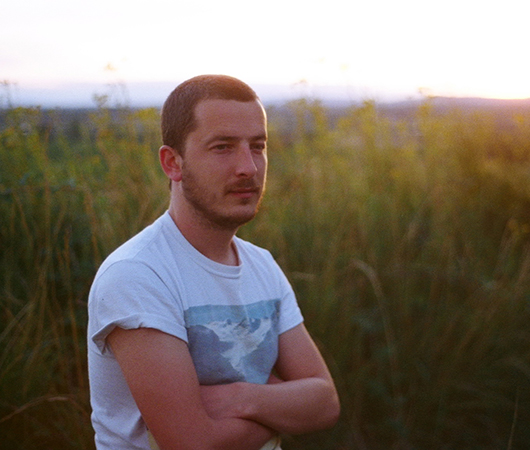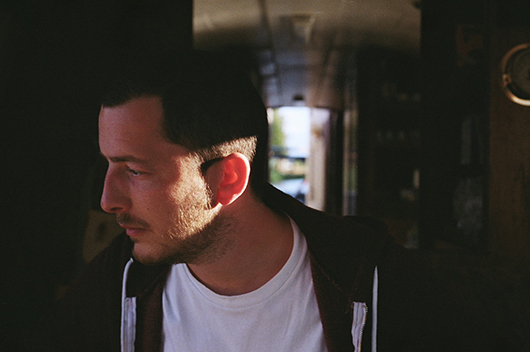Deep Inside: Throwing Snow Talks Fractals, Bass Tones, and the Thought Processes Behind His Debut LP, ‘Mosaic’
Speaking from his flat in South London’s Brixton district, Ross Tones sounds overworked but cheery. […]

Deep Inside: Throwing Snow Talks Fractals, Bass Tones, and the Thought Processes Behind His Debut LP, ‘Mosaic’
Speaking from his flat in South London’s Brixton district, Ross Tones sounds overworked but cheery. […]

Speaking from his flat in South London’s Brixton district, Ross Tones sounds overworked but cheery. Over the past few years, the increasingly hard-to-define producer has developed a reputation for being highly prolific, not just with his own Throwing Snow moniker, but also his side projects (Snow Ghosts, Alight, and Vellico) and his Snowfall label, not to mention the two other imprints he’s co-founded. In short, Tones is busy; prior to our conversation, he had just spent a week recording with Snow Ghosts in the Dorset countryside, jamming on new material in abandoned cathedrals and monasteries using binaural recording techniques, which harness two microphones to create a 3-D audio effect. The ambition of this endeavor—to say nothing of the fact that the release of his proper debut LP as Throwing Snow, Mosaic, was only a few days away at the time of our conversation—seems to be lost on him. “I’ve got so much work at the moment, it’s a bit mad trying to get my head around it,” Tones reflects. “The day before, I go, ‘Okay I’m going,’ and then I disappear off. I don’t really tend to think about the future too much, if you know what I mean.”
Tones may not afford himself the luxury of looking too far ahead, but his musical output as Throwing Snow has thrived on a futurist, genre-blind outlook thus far. During the four years leading up to Mosaic, his previous singles and EPs for the likes of Local Action, Sneaker Social Club, and Snowfall often managed to evade exact categorization. Though he has often been tagged with the vague “bass music” label, his productions are far more varied than that descriptor would indicate, often blending a handful of ominous dance styles, rhythms, and sound sources within the confines of a single cut. His first release for Houndstooth, Pathfinder—an introductory, companion EP to Mosaic that dropped in March—took his craft to a new height, sounding more spacious and organic, yet also doubling down on the menacing, pastiche style.
“I wanted to do an album, but I wanted to be signed first, rather than producing music first and then shopping it around,” he elaborates. “When you’re playing shows, writing other music, and releasing EPs, you don’t get the time to do something more considered. So I wanted to have a year to be able to put it together, rather than just rush it.” This measured approach to writing a full-length seems to have paid off. After receiving an encouraging email from Houndstooth A&R head Rob Booth, he was sold on the young label’s open-minded ethos, which seemed to perfectly cater to his mercurial creativity. Starting work on Mosaic in January 2013, Tones was able to whittle down around 90 tracks—some of them rough loops, others more fleshed out—into the album’s final 11 songs. Though Mosaic does continue on the same train of thought as Tones’ past work, the seams of his patchwork have become cleaner and more intricate. Instead of meshing a select number of influences on a particular track, he has managed to hone his technique and embody a host of styles throughout the entire LP, shifting from house to hip-hop to jungle without giving listeners too much whiplash.
Still, Mosaic is a lot to take in—there’s a genuine abundance of rhythms, sounds, and information. It’s hard not to admire Tones’ obvious work ethic and production chops, but whether his restless collection will find a broad audience is unclear. “If I’m honest, I’ve been so worried about it,” he says. “When I finished [Mosaic], I was like, ‘This is a bit different.’ And I couldn’t really place it myself—with other people, or other directions, or what other people were doing. So in a way, I’ve confused myself. I do like it, but what was in my mind, and what that reality turned out to be—I’m not sure they’re the same thing.”
To be fair, there are noticeable through lines to Mosaic, but mostly in recurring emotions and sounds, like an ominous, guttural bass synth that makes an appearance on nearly every cut. Tones found himself infatuated with “Darkness,” an Ableton Suite patch created by the sound designer Hecq, whose bassline churns in a revoltingly evil fashion. “It’s become my new Reese bassline,” he says in reference to the seminal ’90s drum & bass sound, “but this one’s just become mine, and I adore it, and I find myself reaching for it all the time.” He continues, “It’s like an animal; it’s really difficult to cage in a mix, because it takes up so much space.” Often pairing the bassline with more melodic, field-recorded samples, Tones takes pleasure in the contrast between sublime and hideous sounds.

Female vocals also feature on the majority of Mosaic, adding another counterpoint to Throwing Snow’s grim orchestrations. Tones likens the inclusion of so many vocalists to a narrative with different characters; Romanian singer Adda Kaleh‘s mystical, slinky delivery on “Maera,” for example, grounds the spastic jungle cut’s rhythms to a pop perspective, which makes the listening experience a little more merciful. Boston’s KNOX—who Tones met at last year’s Red Bull Music Academy in New York, along with Kaleh—as well as Py, Kid A, Jassy Grez, and male crooner Russell Morgan all guest on the LP, so there isn’t just one protagonist on the album. As a result, Mosaic may lack a cohesive storyline, but Tones seems content to forego a clear plot in favor of conjuring strong emotions and toying with sounds.
Genre, of course, has always been a difficult subject for him. Studying astrophysics in university, he developed a long-standing fascination with fractals—self-similar, infinitely repeating patterns and mathematical constructs. When transposing that concept to music making, Tones began to find patterns in the farthest-flung styles and sounds, seeing similarities in everything. In a way, the process of creating Mosaic brought his fractal obsession to the surface, which he only began to realize after writing the album. His theory of how genres develop and crystallize also takes an innovative stance. “Hindsight’s always something that you’re like, ‘Oh, that was a punk movement, or this was this movement,’ but they’re not noticed until the future, when you look back on what’s actually happening,” he explains. “So maybe things will solidify a bit more, but at the moment, I’m just really excited by all the things being mashed together. Because people get bored, they don’t want to hear the same track regurgitated thousands of times. People get bored a lot quicker than they used to, really.”
That sort of overstimulated, anything-goes mentality has disheartened some artists, but it’s actually prompted Tones to embrace whatever interactivity he can inject into his own music. Using an augmented reality app called Layar, for example, listeners who own a copy of Mosaic will be able to hold their phone over the artwork and instantly see it animated on the screen, while also hearing a binaural version of lead single “The Tempest.” For Tones, the most compelling idea seems to be linking disparate worlds and embracing duality: physical and virtual, dark and light, tension and release, personal and private.
Whatever genre he happens to be experimenting with, Tones’ music tends to be vicious, cinematic, and highly emotive, and that holds true on Mosaic. From the ceremonial bass dirge that opens “Avarice” to the bleakly warped vocal snippets on “As You Fall,” there isn’t much subtlety to the feelings on display. Yet Tones isn’t trying to establish a persona on the LP, and has little interest in making sexy, playful tracks. “For me, music is like—I’m a really happy, placid guy, but my music can be quite angry and confused… I think I just deal with all of my emotions through music. It’s like a nice, cleansing way. Like colonic irrigation for the soul, or something like that,” he says with a laugh. To that end, Mosaic is refreshingly humble, despite its intricacy. “All the Lights,” for example, starts with naturally sampled squeaks, a hybrid dubstep and hip-hop rhythm, and delicate piano chords before leading into an extended drum & bass jam, but it never feels contrived. Instead, Tones seems to be privately exorcising his emotions and then sharing the results in a pure, unassuming way, which makes the song—and Mosaic in general—both a piercingly honest and awkward listen, but admirable all the same. Tones cites Montreal instrumental outfit Godspeed You! Black Emperor as a major influence, and it’s not hard to make a connection between that band’s long, unadulterated crescendos and Throwing Snow’s overtly passionate work.
Over the course of our conversation, Tones gives the impression that he rarely has time to stop; simply put, there is always so much left to do, whether it’s pausing for a moment to feed his dog dinner or plotting out a new kind of hybridized sound. In a world where genre labels often feel more antiquated and inadequate than ever, Throwing Snow thrives because Tones sees endless potential in cross-pollinated sound. Mosaic is a confident first statement from an artist who is continually inspired by this current landscape, a fact that bodes well for his future output. “I’m writing loads of music at the moment,” he confirms. “When you write and listen to so much music, all day every day, in a way, you spiral out of control. But that’s something that I’ve kind of embraced.”

